
1773 – 1918
The Partitions of Poland and wars relating to them resulted in economic downfall of Staszów. On May and June of 1794 during the Kościuszko Uprising, the land of Staszów became a battleground; this put the town's economy in total disarray. On May 7th 1794 the insurgents clashed with Russian armies near Staszów. From May 12th, 1794 those Russian armies had stayed in Staszów for several weeks, causing great destruction. On May 19th during the march of insurgent armies through Staszów, Adam Czartoryski – August's son – supported the insugrents by giving them 4 large cannons, almost 40 additional cannons of various sizes, and more than 6000 grenades. Towards the end of 1794 Prussian dragoons tore through Staszów, destroying the town and robbing its residents of their property.
In 1795 Staszów and its lands became a part of Austrian Empire, as a direct result of the Third Partition of Poland. Then-heir of Staszów, Elżbieta Izabella Lubomirska – daughter of prince Aleksander Czartoryski – gave the town ownership rights to Ignacy Wielogłowski on May 1st, 1796. Staszów once again became property of Czartoryski family on January of 1802. In 1807 princess Izabella Lubomirska founded a new elementary school in Staszów, and in 1815 stated its rules of conduct and the requirements of its teachers[13].
In 1809 during the Polish–Austrian War, armies of Austrian Empire marched through Staszów. Thanks to Duchy of Warsaw's victory in this war and widening of its borders, Staszów became part of Duchy of Warsaw. As part of the new administrative division of the Duchy, Staszów became the county capital, which it remained until 1844.
In 1809 duchess Julia Lubomirska and her husband, count Jan Potocki (who penned "The Manuscript Found in Saragossa") became owners of Staszów. In 1811 Julian Ursyn Niemcewicz visited Staszów during his official journey across the Kraków, Sandomierz and Lublin provinces[14]. During that period Staszów was undergoing an economic recession. At the beginning of the 19th century, only 8 clothing workshops were still in business. In 1815 due to the Congress of Vienna arrangements most of the lands of Duchy of Warsaw were made into the Kingdom of Poland, fully dependant on Russia. Thus Staszów was annexed into Russia and became occupied. In 1817 the new owner of Staszów – count Artur Potocki – issued and ordinance for improvement of Staszów's building condition. Potocki wanted to upgrade most of Staszów's buildings to brick ones so the town would become more presentable[15]. This concern was partially due to the fact that two years earlier a good portion of the town was damaged in a widespread fire. In 1820 Staszów had the following manufactures: paper mill, clothing manufacture, tannery, dyer and soap manufacture. There were many craftsmen of various trades living in Staszów at the time. The total population of the town in 1820 was 2955 people, including 1393 Christians and 1562 Jews. Theree were 71 brick houses and 283 wooden houses total in the town[16]. In 1821 a mass scale production of clay smoking pipes called "stambułka" began. Those pipes remained very popular until the 19th century and were exported mainly to the east – Russia, Turkey and Middle East. In 1821 Staszów was struck by an epidemic outbreak. Hundreds of residents were its victims. The epidemic had only let up after some residents of Staszów went on a pilgrimage to the sacred painting of Virgin Mary in Sulisławice[17].
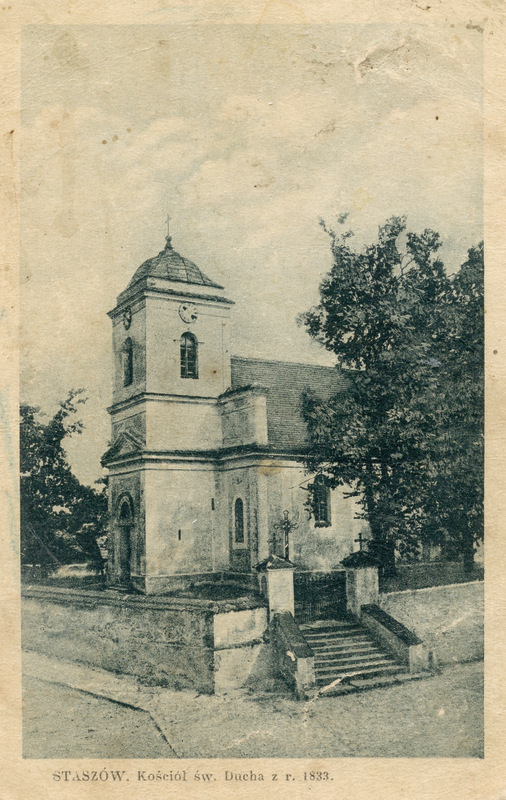 The original Holy Spirit church, destroyed during World War II |
First detailed map of Staszów was made in 1823[18].
During the 1820s Antoni Łobaczewski, a local teacher, ran a theatre group at his school in Staszów. All income from their performances was put towards rebuilding the Holy Spirit church. This theatre group remained active till the 1840s and it was mentioned in the press reaching as far as Central Poland.
In 1823 Artur Potocki further supported Staszów’s clothiers by establishing a „Wool Bank”, meant to accelerate the growth of Cloth Factory. According to official acts from that time, the Staszów treasury established a long-term fund worth 10,000 złoty for the Wool Bank’s cause. In 1826 the numbers of skilled craftsmen in Staszów grew to 92 people, and the town factory made tremendous progress towards improving the quality of goods it produced. The factory of Staszów was counted among the biggest and most important factories in Sandomierz county at the time. Yearly average produce was 137,200 ells total, including 7,440 ells of cloth exported to Russia[19].
In 1824 Staszów had 3866 citizens and had qualified for a third-degree town. It also became the largest town in Sandomierz province at the time, even larger than Radom. However, Radom experienced a rapid population growth after 1824 and soon overtook Staszów as the most populous town. Staszów had remained the second largest town after Radom right until the end of the 19th century[20]. In 1825 then-owner of Staszów, Artur Potocki, funded the construction of clock tower atop the Town Hall, for the convenience of residents. Unfortunately it was not met with an enthusiastic response from the Russian authorities, who complained about a lack of funds for potential repairs of the clock tower[21]. The construction went through despite the complaints. In 1861 the clock was relocated to a tower of the Holy Spirit Church.
Staszów was not unaffected by the important events relating to national uprisings of the 19th century. During spring of 1831 a regiment of Legion of the Vistula was formed in town. Since October 1831 Russian troops had been stationed in Staszów. In the same year the town and the entire country was struck by another cholera outbreak. Due to the epidemy 461 people died in Staszów during only one year, when previously a yearly average death count was just slightly over 100[22].
In 1832 Adam Potocki became owner of the town. In 1833 construction of Holy Spirit church was finished. In 1840, then-mayor of Staszów – Józef Fryben – put together a report about the state of Staszów. In this report he states that there were 357 houses, 2 Roman-Catholic churches and 1 synagogue in the town; he also states the population at 4812 citizens. Potocki also mentions the offices of Staszów: Municipal Office, Province Court, Province Regent, Province Secretary, Tobacco Income Guard and the local teacher[23].
In 1842 a girls' elementary school was opened, with Franciszka Lewarska becoming its principal[24]. The Jewish community had its own synagogues and bachelors teaching their youth.
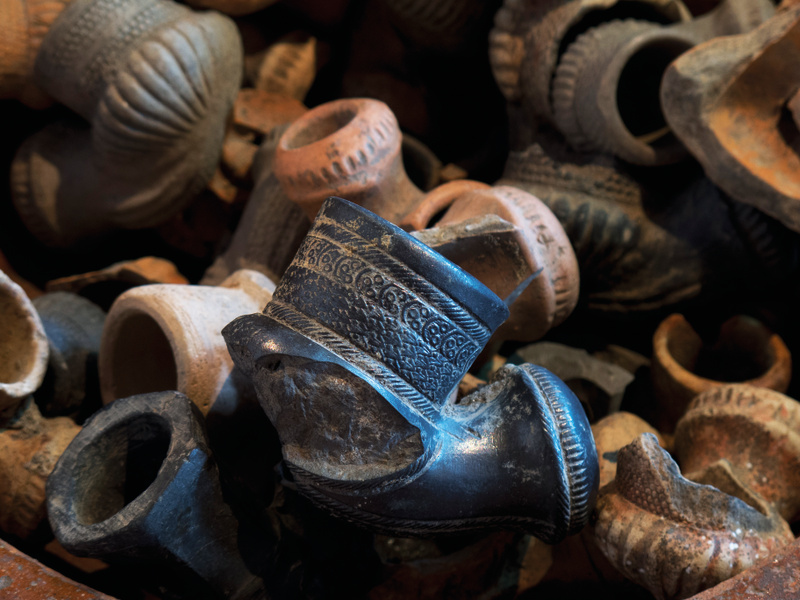 "Stambułka" smoking pipes made in Staszów |
In 1844 Emperor of Russia Nicholas I issued a decree changing the administrative division of the Kingdom of Poland. Staszów was no longer a province capital. In 1848 Adam Potocki abolished serfdom and issued a rent for all small farmers to pay. He also founded the village Adamówka where he gathered Jewish settlers. In 1850 the annual amount of town fairs was reduced to nine. The ceramics production was further developing in Staszów's manufacture, based on a rich tradition of pottery, practiced for ages in the town. During the first half of the 19th century this manufacture was mainly producing the "stambułka" smoking pipes, mostly targeted at eastern markets. In addition the manufacture was also producing clay inkpots and paperweights. During the years 1850-1863 Kunster was the manufacture's owner, and its total production worth was steadily increasing, recorded at 12,490 rubles in 1863[25].
In 1851 the St. Adam Hospital was opened with room for several dozen patients. Dr Melchior Dowgiałło was the head of that hospital[26].
 The bimah of Staszów's synagogue |
Since 1857 a rabbi's office was sustained, and later on in the 19th century a synagogue was opened. Jan Malewski was the mayor of Staszów in years 1840 – 1863. During his time at the office, the town market square and main streets were cobbled and renovated, the streets received their respective nameplates, and a new road to Opatów was built[27]. Furthermore, new parish cemetery was built in 1862.
During the January Uprising, three battalions of the Halicki Infantry Regiment of Russia – led by colonel Zvierov – were garrisoned in Staszów. On February 14th, 1863 Polish general Marian Langiewicz with his army of insurgents came to Staszów. This led to a battle between the two armies on February 17th[28]. Next day, Russian reinforcements have arrived and thwarted the insurgents. After the uprising's failure Russians had burned down and destroyed many of Staszów's houses in an act of revenge. Staszów's residents were victimized for their support of the uprising. Many of them were exiled to Siberia as punishment, including the parish priest Stanisław Fijałkowski. Then-owner of Staszów, Adam Potocki, was opposed to his citizens' participation in the uprising. He fervently implored the insurgents to lay down their weapons. Following the uprising's failure the Russian Empire greatly reduced the rights of many Polish local governments. From that point onward, every mayoral candidacy had to be supervised with Russian governors. First mayor of Staszów elected after the uprising was Jan Jaroszyński, from Rytwiany.
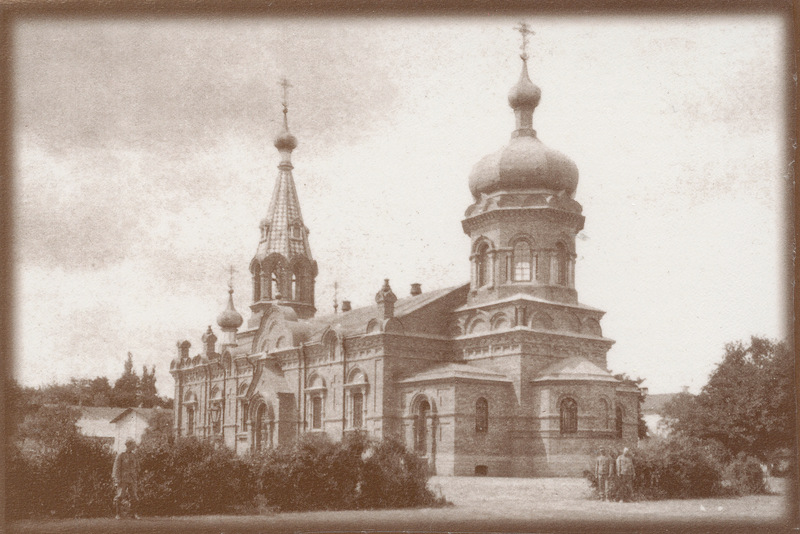 Staszów's Eastern Orthodox Church did not survive to modern times |
In the years 1864-1865, new street lamps were installed in Staszów; however during the same period the amount of town fairs was reduced to six per year[29].
At the end of year 1865 Staszów had 6167 residents, 3947 of them were Jewish. The town along with its surrounding lands belonged to Sandomierz county, Radom governorate.
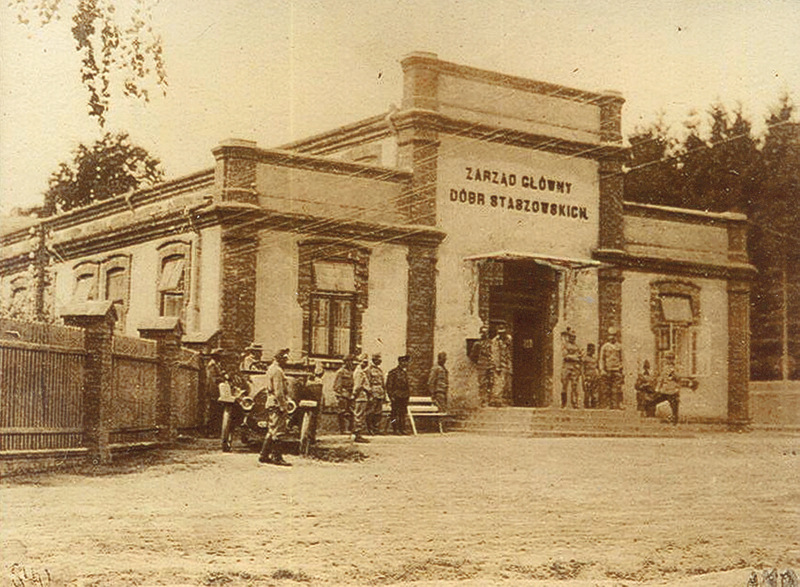 The "Dobra Staszowskie" ("Staszów Goods") administration office in Sichów |
In 1866 Staszów stopped being a private town. Citizens were henceforth considered lawful owners of their property and hosts of the town. At the beginning of this independence the town was in a very poor economical shape. Industry had collapsed, the manufacture stopped functioning, the iron forge closed down in 1870. This was caused by the Russian Empire's neglect of its borderlands. What's more, there was a widespread town fire in 1874 which caused severe damage to the housings near the river Czarna. In 1886, the riverside town park was built. It still exists to this day. Population exceeded 8000 people – most of them were Jewish. A Russian cavalry regiment of 800 soldiers was still garrisoned in Staszów at that time. Barracks, stable, horse-breaking ground and essential warehouses were built to accomodate those soldiers[30].
In 1888 Stefan Żeromski, famous Polish novelist, visited Staszów multiple times during his stay in nearby village – Kurozwęki. He was fairly active in the region's everyday life, for example he attended the funeral of Kazimierz Kraft, Staszów's apothecary.
At the end of the 19th century Staszów was once again hit by natural disasters. In 1893 many townspeople died to another cholera outbreak. In 1895 a fire broke out which badly damaged the Holy Spirit Church.
In 1899 the Staszów Loan & Savings Society was founded. At the end of that year the society had gathered 95 members, 41 of them Jewish[31].
At the turn of the century, Staszów's economy rose back up and once again experienced rapid growth. A brewery, two soda factories, two watermills, a printery and a paper factory were established. Staszów's craftsmanship had re-emerged and once again gained in importance. There were nearly 200 artisans in Staszów at the time, of various crafts: 50 shoemakers, 24 tailors, 20 coopers, 16 bakers, 14 carpenters, 12 bricklayers, 10 hatters, 10 potters, 17 furriers, 18 butchers. Furthermore, there were 120 shops in the town, 80% of which belonged to Jewish owners.
In 1900 the town's Voluntary Fire Brigade was founded. Among its founders were: Bolesław Krauze and Jan Władysław Malewski.
After Wojciech Wciślik's death, Wawrzyniec Siek became the new rector of Staszów parish. In May of 1905, dr. Władysław Roth became head of St. Adam Hospital.
In 1906 agriculture courses were held for small farmers of Staszów. It was the same year that carriage factory – founded by prince August Aleksander Czartoryski – closed down. Thanks to the Polish Motherland School Foundation's efforts, a school library with more than a thousand volumes of books was established.
In 1908 a new Easter Orthodox Church was built next to Krakowska street. Furthermore, the St. Bartholomew Church was renovated and a funeral house was built next to it.
As part of their repression, the Russians exiled some members of the Polish Socialist Party to Siberia. One of those members was Ignacy Raczyński, who would survive the hardships of exile and later return to Poland to become mayor of Staszów.
Wolf Tuchman was elected the Jewish community's leader, and Yehuda Grojbert became the town rabbi.
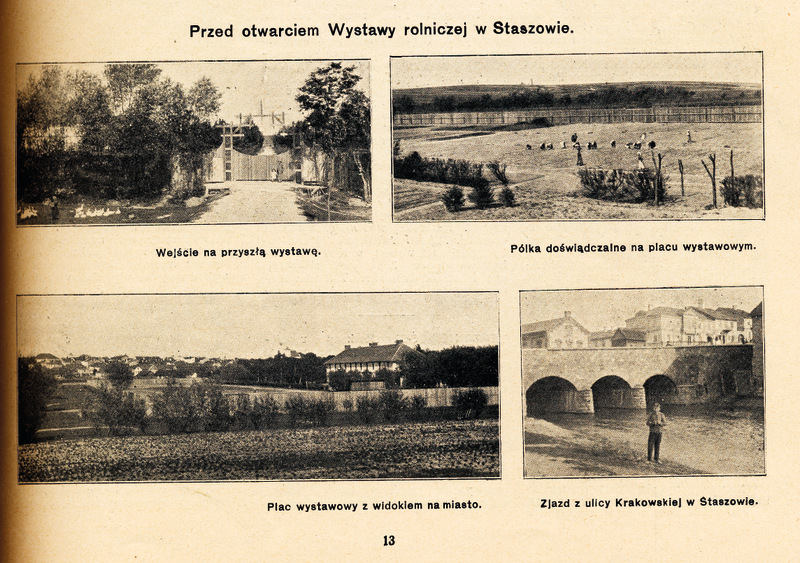
Top: "Before the inauguration of agricultural exhibition in Staszów".
Middle: "Future exhibition entrance" and "Experimental fields at the exhibition grounds".
Bottom: "Exhibition grounds with a view of the town" and "Slip road at the Krakowska Street in Staszów".
On August 24th, 1912, a large exhibition of Radom governorate's economic and agricultural achievements was held. That exhibition was conceived by prince Maciej Radziwiłł. Among its organizers were: judge Jan Władysław Malewski, Leon Karbownicki, dr. Stefan Niewirowicz, apothecary Bolesław Krauze, rector Wawrzyniec Siek, head of the Rytwiany sugar mill Władysław Psarski, and the heir of Kurozwęki Paweł Popiel[32]. During the exhibit various performances were held, including choirs and bands. Those performances had inspired Zygmunt Amborski, an organist, to create a choir in Staszów – he named it "Lutnia" ("the Lute"). Following his death in 1921 his brother Władysław took care of the choir.
In 1913 Staszów had 424 officially registered households, including 282 brick houses. The town's population was 11275 people, which includes the Jewish community of 7634 people. Staszów was the third most populous town in Radom governorate at that time (after Radom and Ostrowiec)[33].
World War I did not steer clear of Staszów. The town was in the middle of a warzone and as a result had been occupied by various occupants at different moments of the war[34]. On August 9th, 1914, the garrisoned Russian troops left the town, and the 14th Regiment of Hungary took their place as the occupants. The same year, on September, the Hungarian troops retreated and the town was once again occupied by Russians. In October, Austrian soldiers took over the Staszów. They maintained their occupation for three years. On December of 1915 Austrians began the construction of a narrow-gauge railroad, which they finished in 1917. Its route went through Szczucin, Staszów, Bogoria and Jędrzejów.
Staszów's first movie theater was opened in 1917.
The Great War ended on November 11, 1918. Residents of Staszów were celebrating Poland's regained independence that day. Among them was a famous general – Józef Dowbór-Muśnicki.
Dariusz Kubalski Ph.D.
English translation by Michał Mróz
Archival pictures from the personal collection of W. Migoń
Footnotes:
[13] AP Kielce Archiwum Dóbr Staszowskich sign. 79
[14] J.U. Niemcewicz, Podróże historyczne po ziemiach polskich między rokiem 1811 a 1828 odbyte, Paryż-Petersburg 1858, p. 79
[15] AP Kielce ADS sign. 53
[16] AP Kielce ADS sign. 11
[17] W. Siek, Opis historyczny…, s. 57-58; A. Bazak, Kult Matki Boskiej Sulisławskiej w parafii pw. Świętego Bartłomieja w Staszowie 1655-2005, Sandomierz 2008, p. 31-32
[18] L. Stępkowski, Staszów w opisach, aktach i dokumentach. Volume I : Do połowy XIX wieku, Staszów 2006 (typescript) p. 133-138
[19] S. Marcinkowski, Miasta Kielecczyzny. Przemiany społeczno-gospodarcze 1815-1869, Warszawa-Kraków 1980, p. 167-168; AP Kielce, ADS, sign. 24
[20] A. Makowska, Prywatne miasto Staszów i dobra staszowskie, Warszawa 1981, p. 197-198, S. Marcinkowski, Miasta Kielecczyzny… p. 121-122
[21] AP Kielce ADS sign. 65
[22] L. Stępkowski, Staszów w opisach, aktach, dokumentach…p. 160-161
[23] AP Kraków, Archiwum Potockich z Krzeszowic, sign. 316
[24] AP Kielce ADS sign. 79
[25] S. Marcinkowski, Miasta Kielecczyzny…p.173-174
[26] A. Makowska, Prywatne miasto Staszów…, p. 258-259, AP Kielce ADS sign. 159
[27] AP Kielce ADS sign. 237
[28] W. Siek, Opis historyczny…, p. 51-52
[29] AP Kielce ADS sign. 237
[30] J. Jadach, Staszów na przełomie XIX i XX wieku,/w:/ Postęp agrotechniczny w regionie świętokrzyskim, Kielce, 2003, p. 135-136
[31] W. Siek, Opis historyczny…, p. 48; M. Zarębski, Staszów wczoraj i dziś…p. 42
[32] S. Maj, Staszowska wystawa rolniczo-przemysłowa /w:/ Postęp agrotechniczny w regionie świętokrzyskim, Kielce 2003, p. 154-164, Gazeta Kielecka, issue 53 from July 10, 1912
[33] Rocznik Statystyczny Królestwa Polskiego. Rok 1913. Warszawa 1914
[34] W. Siek, Opis historyczny… p. 53-54



